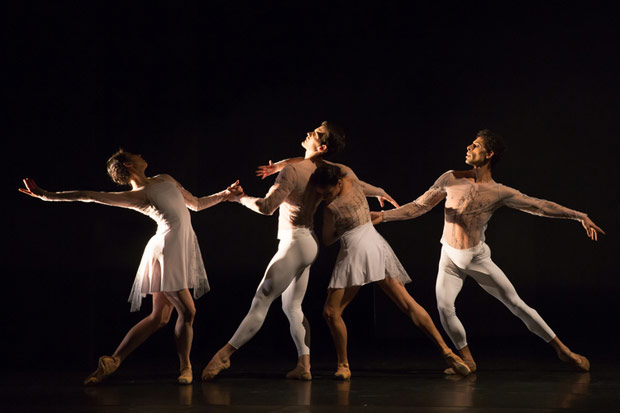
© Andy Ross. (Click image for larger version)
Birmingham Royal Ballet
Wink, The Moor’s Pavane, The Shakespeare Suite
★★★★✰
London, Sadler’s Wells
10 October 2016
www.brb.org.uk
www.sadlerswells.com
Birmingham Royal Ballet has been celebrating Shakespeare’s 400th anniversary by touring a combination of ballets, old and new, inspired by his writing. The triple bill presented in London distils seven plays, comical and tragical, into dance, as well as five of his sonnets.
Jessica Lang’s Wink, created earlier this year, includes the spoken word, unlike the other two works. The title comes from the opening line of Sonnet no. 43: ‘When most I wink, then do mine eyes best see.’ Lang and her set designer, Mimi Lien, picked up on the imagery of blinking by having the dancers swivel 10 white and black panels that define the stage space. The sonnets Lang has chosen make constant references to light and dark, day and night, sleep and death.
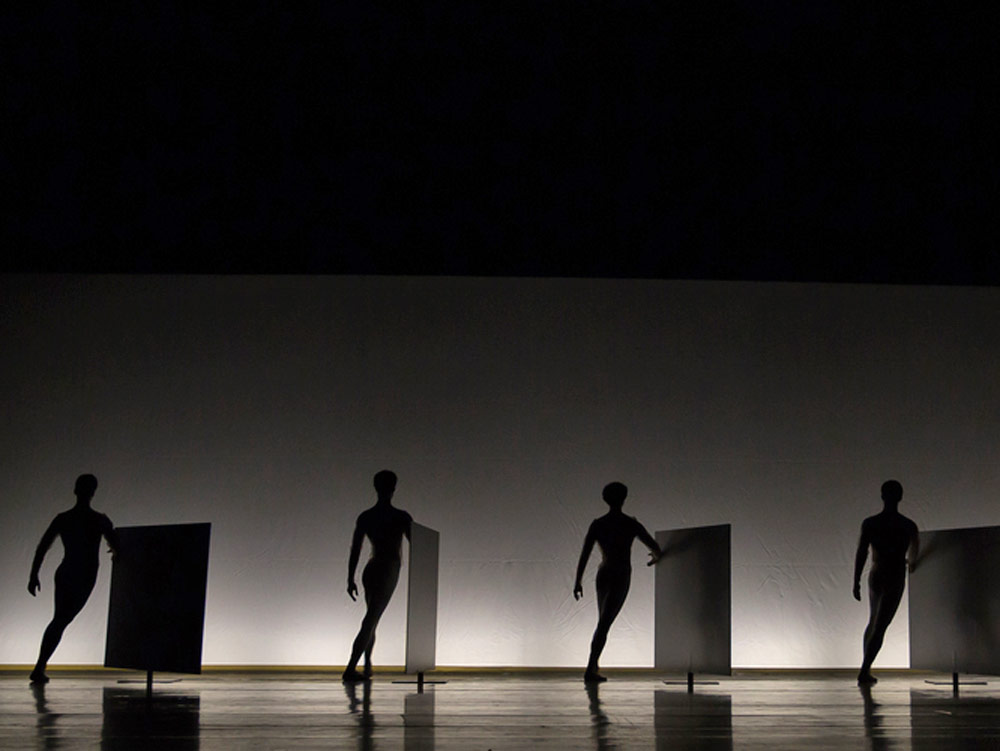
© Andy Ross. (Click image for larger version)
Unfortunately, it’s impossible to listen to the poems because they are so badly read. A good actor can make the sonnets readily comprehensible, dense with conceits though they are. But Lang reportedly selected readings by a youngster of 15 at a theatre school in Warwick. His voice had barely broken and he didn’t yet know how to phrase and punctuate the lines to bring out their meaning. Since the sonnets aren’t printed in the programme, their relevance to Lang’s choreographic inspiration is lost.
She states in a programme note that she didn’t want simply to reproduce the text in dance. Since that would not have been possible anyway, it’s conflicting to have Shakespeare’s poetry made unintelligible while we watch not-too-literal choreography. It is significant that the ballet follows the strict 14-line structure of the sonnets: three quatrains and a concluding couplet are matched by three quartets and a duet. The finale for all 10 dancers alludes to the 10 syllables in each line of a Shakespearean sonnet.
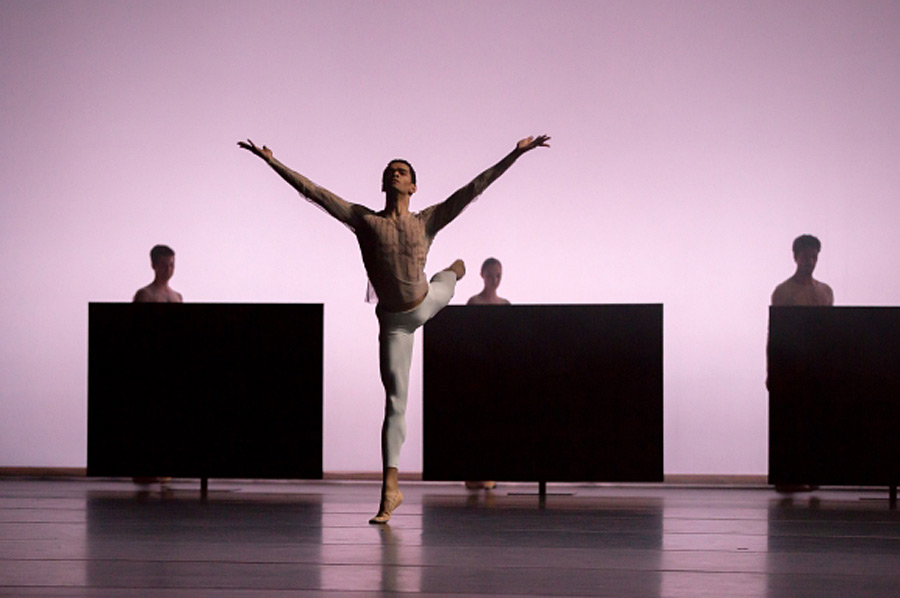
© Andy Ross. (Click image for larger version)
The central role of the poet (Brandon Lawrence) links the sections. He dances to the vocal rhythms of the voice-over sonnets, mostly about love, loss and mortality. Lawrence is impressive in his gravity, combining his elegant classical line with supple expressive anguish. The first quartet is for two couples, shadowing each other in a dreamy double duet, swapping partners as the panels revolve behind them.
Then four men link arms in a laddish, folk-dance second quartet. Delia Matthews joins in, manhandled amongst three of them as if she were a rugby ball. The poet selects blond Lewis Turner (a reference to Shakespeare’s Fair Youth) for a duet that becomes complicated with the involvement of Matthews, the Poet’s rival mistress. In the last section, Lang plays a dazzling numbers game with the cast and black-and-white panels before positioning nine dancers in a poignant tableau. The poet leaves to the final sonnet: ‘No longer mourn for me when I am dead’.
Yes, the words do matter. Their amateurish reading mars an otherwise skilfully constructed work of visual patterns, using a big vocabulary of small and expansive steps, pointe work and contemporary dance moves. Wink, best seen from above, is a valuable addition to BRB’s repertoire.
So is José Limon’s The Moor’s Pavane, created in 1949. The formality of a stately Remaissance pavane contrasts with the seething emotions of the two couples who perform it to Purcell’s music. Although Limon preferred to keep their identities universal, they are Othello and Desdemona (Tyrone Singleton and Delia Matthews), Iago and his wife Emilia (Iain Mackay and Samara Down).
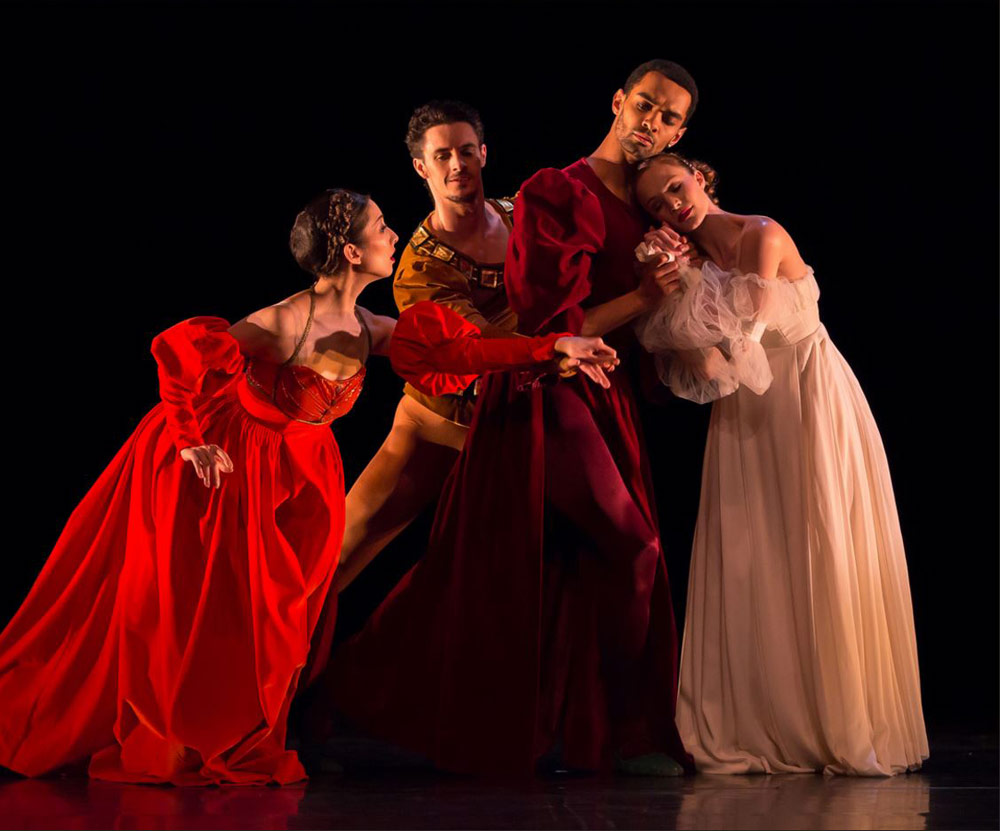
© Andy Ross. (Click image for larger version)
The deep curves of modern dance alternate with baroque flourishes as the four characters circle and confront each other. Their gorgeous costumes, originally designed by Limon’s wife, form part of the choreography. The Moor’s velvet robe emphasises his high status; Iago’s short tunic reveals his legs in dagger-like moves, one leg wrapped insinuatingly around Othello’s waist; the women’s long skirts swirl and swoop. Desdemona is innocently malleable, Emilia in thrall to her lascivious husband.
BRB’s cast(s) have grown into their roles, bringing them vividly to life. When last I saw Rudolf Nureyev perform the Moor, towards the end of his career, he could only go through the motions. Tragically, the Pavane looked grotesque, dated and dull. No longer, thanks to the direction and coaching of Jennifer Scanlon (formerly of Limon’s company) and the heartfelt interpretations of the dancers.
Even more compressed than Limon’s treatment of Othello is David Bintley’s Shakespeare Suite, from 1999. Set to music by Duke Ellington and Billy Strayhorn, the jazz suite was played at Sadler’s Wells by Colin Towns’ Mask Orchestra, conducted by Paul Murphy. The choreography is a mash-up of jazz ballet and vaudevillean hoofing. Jasper Conran’s larky costumes bring Bintley’s caricatures of Shakespeare’s characters up to date.
Six duets are performed by oddly-assorted couples from plays ranging from The Taming of the Shrew to Macbeth, A Midsummer Night’s Dream to Othello. Lawrence and Matthews appear again as the Moor and Desdemona, he with dreadlocks, she in a skimpy frock. Because Desdemona’s abrupt murder is more brutal than in Limon’s Pavane, the treatment of her death to jolly jazz music seems unduly callous. The tone of the Macbeth extract is more effective, thanks to Céline Gitten’s compelling presence as Lady Macbeth, egging on her bad, be-kilted husband (Mackay). Gittens can certainly command a stage.

© Andy Ross. (Click image for larger version)
Valentin Olovyannikov gets to be a Mafia-style villain as Richard III, with a limp instead of a hump. Arancha Baselga is the Lady Anne who succumbs to his dubious charms. William Bracewell and Jenna Roberts paddle palms as Romeo and Juliet in a pretty duet with a presentiment of death. Doomed Hamlet (Mathias Dingman) has two solos, one at the start to show his antic madness, the other, near the end, his existential angst, accompanied by a black-clad chorus line. A virtuoso number, it leads into a frenetic finale for all the cast until Hamlet puts out the brief candle of the suite’s performance.
It makes for a good-humoured ending to an otherwise solemn triple bill. Not much light is shed on Shakespeare in his anniversary year, though the three ballets Bintley has assembled are original, one a modern dance classic and the other two created for the company. Instead of relying on over-exploited Romeo and Juliet, he has choreographed his own account of The Tempest, to be shared with Houston Ballet.
















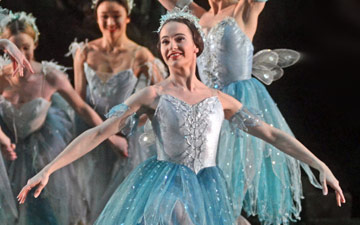
You must be logged in to post a comment.